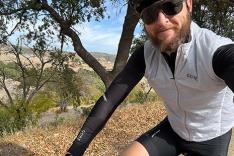Isolated Leg Drills
To complete isolated leg drills, start by unclipping one foot from the pedals. Rest it on a box or other platform where it'll be out of the way. Try to keep both hips in a normal riding position if possible.
Pedal using only the leg that's clipped in for 30 seconds. At the end of 30 seconds, clip both feet back into the pedals and spin easy for 15 seconds. Repeat with the opposite leg and complete this cycle 4 to 5 times.
If you notice during this drill that your stroke is jerky or uneven, pay attention to where it occurs in the pedal stroke. This is an indicator of where your stroke inefficiencies are. Remember to try to keep your hips, glutes and core activated throughout the stroke, which will help to make each revolution more even.
Push-Push-Pull
This drill can be done on a trainer or on the road. It's a great way to stay mindful of your pedaling efficiency and form. The drill is simple: As you pedal, focus on the push-phase (down stroke) for two revolutions and then the pull-phase (upstroke) for one. If you perform this drill on an extended climb, it can help to keep your rhythm constant, which will help generate more power.
More: Should You Train at a Non-Optimal Cadence?
When you're on an indoor trainer, do this as part of your warm up to activate each muscle group before you begin your workout. You can also sneak a couple of these drills in during the ride.
Cadence Progressions
A great way to maximize efficiency is to learn to hold the same power (or perceived exertion or heart rate if you have no power meter) across different cadences. To begin, you need to find a power output to maintain throughout the progression. Zone 3, which is between 75- and 90-percent of your functional power threshold, is ideal for most cyclists.
If you're training by heart rate, stick to Zone 4, which is between 80 and 90 percent of your heart rate threshold. If you're going by perceived exertion, try to maintain an effort that you could maintain for one hour.
More: Bike Cadence and the Tour de France
1. Pedal at 80 rpms and hold for 5 minutes.
2. Once you reach the 5-minute mark, increase your cadence to 85 rpms and hold for another 5 minutes.
3. At the 10-minute mark increase to 90 rpms.
4. After you've ridden for 15 minutes, increase your rpms again to 95 and hold for a final 5 minutes.
5. Spin easy for 5 minutes and then repeat this progression for a second time.
Putting It All Together
To improve your pedal stroke, it needs to be the focus of at least one workout per week. Here is a trainer workout that combines all of the above drills into one program that'll get you started:
1. Start with 5 to 10 minutes of easy spinning.
2. Complete 5 minutes of isolated leg drills.
3. Do 5 minutes of push-push-pull drills.
4. Spin easy for 2 minutes.
5. Begin cadence progressions:
* 5 minutes at 80 rpm, 5 minutes at 85 rpm, 5 minutes at 90 rpm, 5 minutes at 95 rpm
* 5 minutes easy spin
* 5 minutes at 80 rpm, 5 minutes at 85 rpm, 5 minutes at 90 rpm, 5 minutes at 95 rpm6. Cool down with 5 to 10 minutes of easy spinning.
More: 3 Ways to Improve Your Pedal Cadence
 Ready to ride? Search for a cycling event.
Ready to ride? Search for a cycling event.
- 2
- of
- 2
About the Author









Discuss This Article